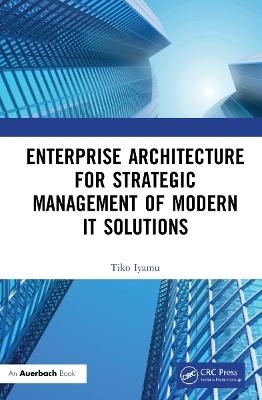
Enterprise Architecture for Strategic Management of Modern IT Solutions
Auerbach (Verlag)
9781032145297 (ISBN)
The popularity of enterprise architecture (EA) has increased in the last two decades, in both business and academic domains. Despite the cumulative interest from all sectors, the implementation and practice of EA have been entangled with numerous challenges and complexities. Consequently, some organisations continue to theorise the concept, which has ramifications on practice and ROI. This has led to many studies that have been conducted, to understand the complexities impacting the implementation and practice of EA in organisations. Yet, the trajectory of some convolutions remain a mystery in many quarters. This attributes to the struggle to articulate the value of EA in many environments. Hence many organisations find it difficult to apply EA for strategic management of modern information technology (IT) solutions.
Enterprise Architecture for strategic Management of Modern IT Solutions provides guidance on how to employ EA in deploying and managing IT solutions from pragmatic and implementable perspectives. Until now, implementation and practice of EA have been slow, despite its growing popularity and interest from all sectors. This book employs sociotechnical theories such as actor-network theory (ANT) and structuration theory (ST) as lenses to examine and explain why and how challenges and complexities exist and derail the implementation or practice of EA in organisations. This serves to enable practitioners and readers to gain fresh insights on why the challenges exist and how they can be addressed in creating collaborative capabilities for business enhancement, sustainability, and competitiveness.
The book provides detailed insights on how to apply EA for organisational purposes, from three main fronts. First, it explains the implications that lack of understanding of EA have on organisational activities and processes. Second, it examines the challenges and complexities that hinder the implementation and practice of EA in organisations. Third, it proposes models and frameworks on how EA can be applied for strategic management of modern IT solutions in organisations.
Written for postgraduates, researchers, academics, and professionals in the fields of EA, IT, and information systems, this book provides a valuable resource that will enable and enhance implementation and practice of EA including future studies.
Tiko Iyamu holds a PhD in information systems from the University of Cape Town, South Africa. Currently, Iyamu is Research Professor at the Faculty of Informatics and Design, Cape Peninsula University of Technology (CPUT), Cape Town, South Africa. Previously, he was with the Tshwane University of Technology, South Africa, and Namibia University of Science and Technology, Namibia. Iyamu served as a Professor Extraordinaire at the Department of Computer Science, University of the Western Cape, from 2006 to 2015. In 2014, he was a visiting professor at the Flensburg University of Applied Sciences, Germany. Professor Iyamu’s areas of focus include enterprise architecture, health informatics, big data analytics, and mobile computing. In addition, he has keen interest in the application of sociotechnical theories, such as actor-network theory, structuration theory, and diffusion of innovation for information systems research. He has authored seven books, and over 140 peer-reviewed research articles in journals, conference proceedings and book chapters. He has received several excellence awards in research and in supervision of postgraduates.
1. Introduction 2. Information Technology Solutions 3. Introduction to Enterprise Architecture 4. Data and Information Architectures: The Confounded Confusion 5. Business Analysis and Business Architecture: The Implications for Organizations 6. Theorising Enterprise Architecture into Practice 7. Structuration View of Enterprise Architecture 8. Readiness Assessment Model for Enterprise Business Architecture 9. Enterprise Architecture as Agent of Change for Enterprises 10. Unified Architecture Framework for Enterprises 11. Assessing the Value of Enterprise Architecture in Organisations 12. A Capacity Maturity Model for Enterprise Architecture
| Erscheinungsdatum | 18.03.2022 |
|---|---|
| Zusatzinfo | 24 Line drawings, black and white; 24 Illustrations, black and white |
| Verlagsort | London |
| Sprache | englisch |
| Maße | 156 x 234 mm |
| Gewicht | 498 g |
| Themenwelt | Mathematik / Informatik ► Informatik ► Datenbanken |
| Mathematik / Informatik ► Informatik ► Netzwerke | |
| Mathematik / Informatik ► Informatik ► Software Entwicklung | |
| Mathematik / Informatik ► Informatik ► Theorie / Studium | |
| ISBN-13 | 9781032145297 / 9781032145297 |
| Zustand | Neuware |
| Informationen gemäß Produktsicherheitsverordnung (GPSR) | |
| Haben Sie eine Frage zum Produkt? |
aus dem Bereich


